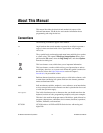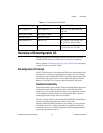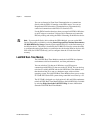
Chapter 1 Introduction
© National Instruments Corporation 1-5 NI 783xR User Manual
The FPGA logic provides timing, triggering, processing, and custom I/O
measurements. Each fixed I/O resource used by the application uses a small
portion of the FPGA logic that controls the fixed I/O resource. The bus
interface also uses a small portion of the FPGA logic to provide software
access to the device.
The remaining FPGA logic is available for higher-level functions such as
timing, triggering, and counting. The functions use varied amounts of logic.
You can place useful applications in the FPGA. How much FPGA space
your application requires depends on your need for I/O recovery, I/O, and
logic algorithms.
The FPGA does not retain the VI when the R Series device is powered off,
so you must reload the VI each time you power on the device. You can load
the VI from onboard flash memory or from software over the bus interface.
One advantage to using flash memory is that the VI can start executing
almost immediately after power up, instead of waiting for the computer to
completely boot and load the FPGA. Refer to the LabVIEW Help for more
information about how to store your VI in flash memory.
Reconfigurable I/O Applications
You can use the LabVIEW FPGA Module to create or acquire new VIs for
your application. The FPGA Module allows you to define custom
functionality for the R Series device using a subset of LabVIEW
functionality. Refer to the R Series examples, located in the
<LabVIEW>\
examples\R Series
directory, for examples of FPGA VIs.
Software Development
You can use LabVIEW with the LabVIEW FPGA Module to program the
NI 783xR. To develop real-time applications that control the NI 783xR, use
LabVIEW with the LabVIEW Real-Time Module.
LabVIEW FPGA Module
The LabVIEW FPGA Module enables you to use LabVIEW to create VIs
that run on the FPGA of the R Series device. Use the FPGA Module VIs
and functions to control the I/O, timing, and logic of the R Series device
and to generate interrupts for synchronization. Select Help»Search the
LabVIEW Help to view the LabVIEW Help. In the LabVIEW Help, use the
Contents tab to browse to the FPGA Interface book for more information
about the FPGA Interface functions.


















